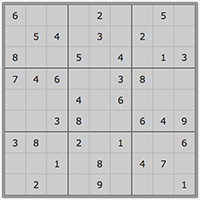The history of sudoku
Almost every popular game has its homeland. For instance, England is said to be the homeland of football, and India is the homeland of chess, at least, it is generally agreed to be so.
So what do history and facts tell about sudoku? We suggest you to get to know this game better and gradually find out about all stages of the development of its popularity.
1st century AD
A game in a form of a small square – its size was only 3x3 cells – appeared in China. According to the rules, numbers from 1 to 9 had to be inserted in it. But the most important thing was that the total sum of numbers in any row, column and even diagonal had to equal 15. We can say that this was when the history of sudoku began.
17th century. The era of numbers
Leonhard Euler, a Swiss mathematician, mechanic and physicist, invents a game and calls it “The Latin square”. Later, records were found in his archive, containing information about the “magical square” with a certain number of cells (he paid special attention to 9, 16, 25 and 36).
But the genius mathematician didn’t stop at that – as is known from the document he called “Scientific research of the new kinds of magical square”, Euler replaced numbers with letters. This is how he got the Greek Latin square.
Why doesn’t sudoku history record this fact? Because even the mathematician himself faced the problem: how to combine symbols so that none of them will repeat in any line and in any column?

The 70s years of the 19th century. The dawn of sudoku
Special crosswords comprising numbers appear in the North America. They first appeared in 1979 in Dell Puzzle Magazine under the name “Number Place”. The author of the “new” puzzle was Harward Harris, who used the Latin square principle.
But he worked with the matrix comprising 9x9 cells, and also he added a new rule: now numbers mustn’t repeat in internal squares comprising 3x3 cells.
1980s-1990s. Japanese roots
In 1984 Japanese company “Nicoly Inc.” published in its newspaper Monthly Nicolist a whole collection of puzzles grouped under a heading “Each number can be used only once”. This is when the word “sudoku” appeared, comprising two Japanese words: “su” – number + “doku” – the only.
1990s – present

In 2004 this puzzle appeared on the pages of The Times – and has been regularly appearing in newspapers and magazines worldwide ever since. Nowadays some publishing houses issue small collections containing only sudoku of different difficulty levels. And, of course, this puzzle couldn’t avoid appearing on the Internet which is working in almost every building of our country.
Hence, sudoku got the name “modern Rubik’s cube”. Solving this puzzle for a while, you will get rid of memory issues, learn to concentrate better and enlarge your thinking.